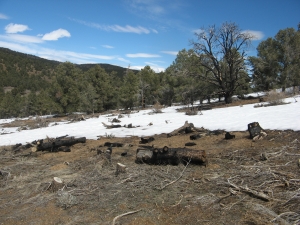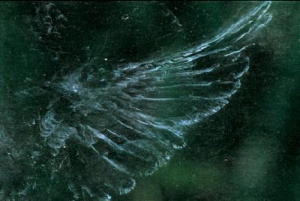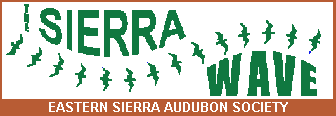
Eastern Sierra Audubon
Sierra Wave Newsletter
Volume 29, Number 5
May-June, 2011
Contents
- Events:
- Features:
- Reports:
- Conservation:
- Business
Events
You Are Invited
To the Annual
Audubon June Picnic!
Where: Izaak Walton Park, Bishop. The park is located at 3600 West Line Street in Bishop, just west of Reata Road.
When: June 1st, 6:00 pm
Audubon members and friends are invited to attend our annual picnic on Wednesday, June 1st, starting at 6 pm at Izaak Walton Park in Bishop. We look forward to another fun social event with great conversation and lots of good food. We ask each participant to bring an ample dish and beverage to share, your own place setting and a folding chair. Invite a friend or neighbor to enjoy a lovely picnic in the park on the banks of Bishop Creek.
This is the chapter's annual meeting at which the election of the Eastern Sierra Audubon officers and members of the board of directors takes place. We will hold the election after dinner, but we need candidates! If you would like to nominate a candidate or be considered as a candidate, please come to the meeting or contact a board member in advance of the meeting.
We need a new Vice President, to learn the ropes with our current president and be ready to step into that position when he steps down, and we desperately need a Program Chair, to help us find and organize our evening programs (only 4 a year, plus this picnic, now). We could also use a Publicity Chair to make sure we get information to the local news in a timely manner, and anyone is welcome to become a General Board Member to meet and help plan the activities of the chapter, oversee finances, guide the chapter in conservation matters, participate on behalf of the chapter at events and programs and share their ideas and enthusiasm with the other members of the board. It's a great group of folks to work with!
Please contact any member of the Board if you are interested in filling any of these positions.
Please Bring:
- An ample dish and beverages to share,
- Your own plates, silverware, drinking glasses and ice,
- A folding chair (there are picnic tables at the park, but they are scattered around and chained in place),
- A friend who might be interested in Audubon!
- Also, if you have a table that can be used for serving up food, please bring it. Thank you!
For more information call Roberta at 760-872-7846. Everyone is welcome to attend!
Back to Top
Upcoming Field Trips and Events
Bishop Creek Birding, Sunday May 22nd, 8:20am
In May, Fox Sparrows, pewees, sapsuckers and warblers are mountain birds we expect along Bishop Creek. We'll walk easy paths along both sides of the rising stream. Before the morning ends we'll also take a short walk along South Fork Bishop Creek. Meet at 8:20 am in the parking lot west of Joseph's Market in Bishop, or at the junction of the Lake Sabrina/North Lake road above Aspendell at 9:00 am. Bring snacks, liquids and warm clothes. For more information, contact leader Larry Nahm at 872-4125.
Lundy Canyon Field Trip, Friday, June 3rd, 9am
Join Dave Marquart, Mono Lake Tufa State Reserve naturalist, for a half-day birding trip up Lundy Canyon. With its stunning peaks, waterfalls, aspen groves, and all-around great diversity of habitats Lundy is one of the most magical canyons on the Sierra’s east side. Bring lunch and water and be prepared for possibly cool and breezy weather. Meet at the Mono Lake County Park on Cemetery Road five miles north of Lee Vining off of Hwy. 395 at 9:00 am. We’ll carpool to Lundy from there. Call Dave for more information: (760) 647-6344 or (760) 209-3018. If the weather looks marginal the morning of the 3rd, call Dave for a weather report.
Mono Basin Bird Chautauqua: Friday-Sunday, June 17-19
This year the Chautauqua is offering 75 individual events led by 48 presenters from California and across the nation. We were pleased to have the most enthusiastic response ever on registration opening day, April 15th. We had 150 people registered in the first 1 1/2 hours after registration opened. "Not your ordinary bird festival," is our official slogan. In keeping with that we're offering an evening presentation by a NASA scientist on how Mono Lake's extreme environment can prepare Mars rovers for future Mars missions. In addition to many birding field trips and workshops we're also offering events on local geology, plants & wildflowers, small mammals, butterflies, animal tracking, kids events, and the importance of silence and dark skies. There is still space available in over 40 events. For more information and to register please visit: www.birdchautauqua.org.
Back to Top
Articles
President’s Message
“Last night, the first time,
raccoons opened
the refrigerator.
You can’t slow down
Progress.”
— Gary Snyder
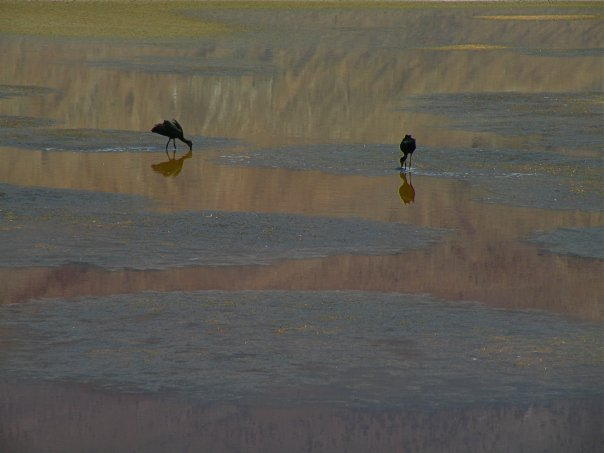
White-faced Ibis on Owens Lake, with reflections of Inyo Mountains
Photo by Mike Prather
Recently, Eastern Sierra Audubon was awarded the Andrea Lawrence Award in recognition of “its critical efforts to support the Owens Lakebed Master Plan.” This is extremely gratifying and I thank everyone who has played a role in moving the planning process to a point where it is deserving of such acknowledgement. I wanted to share with you my remarks at the acceptance ceremony.
It is an honor to receive an award which honors the life and vision of Andrea Lawrence. Her life was all about responding to challenge and her legacy of spirit and devotion to the Eastern Sierra shines as an inspiration to those who have the good fortune to make this place their home. One of our rules in the Owens Lake Planning process is that no one speaks for anyone else, so my thoughts are my own.
Eastern Sierra Audubon is pleased to accept this award, not as a recognition of its own actions, but rather on behalf of the more than 50 stakeholders and other participants in the Owens Lakebed Planning process. I know that there are persons here tonight who have been involved in this process and I would ask that they stand for a moment and join me in accepting this honor.
All of those diverse groups and individuals are here in spirit. I have been admonished that this is not the academy awards and I cannot thank everyone who deserves appreciation. My wife tells me that people’s eyes glaze over when I talk about Owens Lake so I will refer you to our website “Owens Lakebed” for further information.
I have thought a lot about this process since learning of this honor and I am amazed again and again at how unusual it is. At a time when so many people have so much trouble dealing productively with each other on any issue at any level of discourse, we have managed to work very productively for eleven day long meetings of the planning group and more than twenty meetings of topic specific work groups spread over a period of 14 months
It has been a pleasure to watch the warnings that “this will never work” evolve into questions of “how have you done this?” There are probably as many answers as there are participants, but I would like to highlight a couple of things.
Like so many here, I did not have enough opportunities to talk with and learn from Andrea. One lasting memory I have is that, in nearly every conversation we had, she would, at some point, raise an issue saying “We have to do something about….” There are three critical parts to this seemingly simple phrase.
“We”…not you, or I on my own, or them; but all of us who are involved or touched by a given situation. We must do this together and invite anyone and everyone with something to contribute to join in.
“Have to”…there is not a choice. If something needs doing, it must be done. If a problem needs to be addressed and resolved, we must do so. There is no option to let things fester to leave the hard work to someone else.
“Do Something”…not just talk; or argue or accuse; not just plan or study, but actually develop options, put them to the test of public scrutiny and, select the most promising and do the work involved in getting it done.
In order to do our something we have had to focus tightly on the task at hand. Those who said we would fail relied on well-known factors of history, baggage, past animosity, scores to be settled and mistrust. There has been a resolve to not allow ourselves to be imprisoned by the past. At Owens Lake, the time has come to set that past aside and suspend judgment about one another in order to actually listen to each other and learn about the nature of the interests in the room. What we learned was that the imperatives and objectives of the participants were not mutually exclusive, but rather had the potential to re-enforce and support a common vision. This requires a very conscious effort and a clear focus on a specific task. I cannot say that everyone now trusts everyone else, but we are able to work together on this single task, as massive as it might be.
This is what Andrea was about and I dare say I think she would be pleased by what is going on with Owens Lake.
We are, of course, not out of the woods. The devil is indeed in the details and the most important decisions and hardest questions are the ones that lie at the end of the process. What we have learned, I think, is that we can work together, even if it is hard. We can listen, even if it is not exactly what we wanted to hear. We can respect one another and disagree without fighting. We do not automatically dismiss what is being said because of who is speaking. That is a big deal for this place and these people. The path that has led us here is the thing that suggests we can succeed.
And, although it is against the rules, I am willing to speak for all of the planning participants and say thank you for this vote of confidence.
Pete Pumphrey
Back to Top
Eastern Sierra Audubon Awarded Andrea Lawrence Award
On April 29, 2011, the Eastern Sierra Audubon Society was awarded the 2011 Andrea Lawrence Award at a dinner at Parallax Restaurant at Mammoth Mountain. The setting was beautiful and attendees enjoyed dinner and conversation as the sun set behind the Sierra crest. Remarks were made by Quentin Lawrence, Geoff McQuilkin of the Mono Lake Committee, Rusty Gregory of Mammoth Mountain and the keynote speaker was Ron Nichols, General Manager of the Los Angeles Department of Water and Power.
The award, which is a framed photo from the Sierra along with an image of Andrea was presented by Geoff McQuiliken and Quentin Lawrence. The Award reads, “[t]he 2011 Andrea Lawrence award celebrating passionate engagement in community and the land is awarded to the Eastern Sierra Audubon Society in recognition of its successful efforts to initiate the Owens Lake Master Plan process in order to achieve the best possible future for Owens Lake and its wildlife. Andrea Lawrence was a visionary environmental leader, an Olympic double gold medalist, and a mother of five who tirelessly pursued a principled vision of how ecological integrity, economy and the community can thrive in a way that preserves the vitality of each and enhances the whole. The award commemorates those who carry on her legacy of environmental conservation.”
Eastern Sierra Audubon accepted the award on behalf of the stakeholders who make up the Owens Lake Planning Committee and have spent hours and hours over the past fourteen months on the development of a master plan for the lake. Draft elements of the plan have been developed which address issues of cultural resources, renewable energy, development of dust control methods, public access, recreation and education and habitat and wildlife resources. These materials and others are available on the planning group’s website OWENSLAKEBED. The next two months will see the completion of the first administrative draft. Once in that form, the plan will proceed through the CEQA process beginning with public scoping meetings and public comment periods.
[To read more about the dinner, see the Mono Lake Committee's story, "Andrea Lawrence Award Dinner a Rousing Success"]
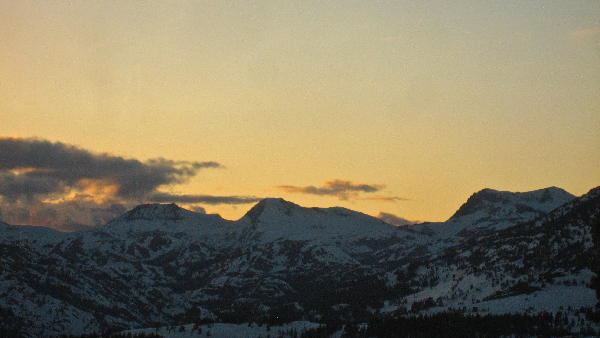
The view from Parallax, where the Andrea Lawrence Award dinner was held.
Mount Andrea Lawrence, center. Photo by Maggie Riley
Back to Top
Some Shout Outs to Joan Benner
Joan Benner has retired from the Eastern Sierra Audubon Board - she has served so long and so well, the members who have known her the longest wanted to give a little tribute and thanks to her for all she's done.
Joan Benner is a rock upon which the Eastern Sierra Audubon Society was founded and has received support for more than twenty five years. She was there at the initial organizational meetings and continued to serve the chapter, most recently as Vice President and a member of the Board of Directors. She has stepped down from these positions and ESAS is much the poorer for this.
She had an extremely positive influence on all aspects of the chapter’s activities. She was the person who knew how to arrange meetings, dinners, potlucks, the chapter archives and just about anything else that needed to be put in order. She knew where things were kept and to which they should be returned, what was needed to get the room ready for the meeting, how to coordinate our schedule with the White Mountain Research folks, and made things special with touches like the candles and centerpieces that graced the Christmas potluck dinners. She was a source of oft needed humor, energy, creative ideas and practicality during board meetings and again and again stepped up to undertake the things that need to be done to keep a volunteer organization moving forward.
It is hard to imagine and Eastern Sierra Audubon without Joan at the forefront. All of the members of ESAS owe her an enormous thank you, we wish her well and hope to see her as often as possible in the future. Joan, you are simply the best.
Pete Pumphrey
have known Joan since our Schulman Grove days together on the Inyo National Forest in the White Mountains way back in 1988. It has been a pleasure to serve with her on the Eastern Sierra Audubon board over the years. Joan always has good insights to the most productive ways to work in partnership with the agencies. I look forward to consulting Joan on her gardening expertise at the nursery and hearing her wonderful stories of adventure.
Kathy Duvall
Joan Benner has always been there for Eastern Sierra Audubon Society and for the wild creatures and places we have pledged to defend. She has been passionate about our place and protective of our many creatures. Joan has done almost every job for Audubon, from President to bringing cookies. For many years when Audubon hosted an Owens River clean up on Earth Day, Joan organized the event. Literally hundreds of people picked up tons of trash and moved it to the appropriate dump. Joan has been there for the little stuff, making sure we had a meeting room, cookies and drinks, and for the big stuff, helping plan strategy for wildlands protection and protecting local wildlife. No one has more consistently been there for Audubon and the environment for the last 25 years than Joan. We all, members, board, and all of the creatures, lizards, bighorn sheep, and sage grouse, owe her collective thanks, Big Thanks. Thank you Joan.
James Wilson
Back to Top
Feature: Black-tailed Gnatcatcher
Black-tailed Gnatcatcher in Inyo County
By Tom & Jo Heindel
Click on any of the photos for a larger version (may take a little while to show up, depending on your internet connection speed)

Black-tailed Gnatcatcher,
Indian Ranch (Panamint Valley),
Photo by Tom Heindel
The Black-tailed Gnatcatcher (Polioptila melanura) is a small foliage-gleaning insectivore whose distribution is limited by habitat and climate zones that can maintain year-round provisions of insects. The preferred habitats are dense spiny shrubs dominated by Quail Brush and other members of Atriplex as well as mesquite thickets especially in well-vegetated washes. In southernmost Nevada, they occur in creosote bush-dominated playas and bajadas as well as densely vegetated desert washes and oases (Floyd et al. 2007:388). In Joshua Tree National Park it is found primarily in catclaw acacia thickets (Miller and Stebbins 1964:187) and at the Salton Sea they utilize desert scrub and frequent salt cedar (Patten et al. 2003:252). Distribution is primarily in Southwestern U.S. and central and western Mexico. This sedentary resident remains paired year-round (Unitt 2004:433) and is seldom reliably reported away from its known breeding areas where it remains throughout its lifespan. The elevational range is limited with most populations between 75-900 m (246-2954 ft) and breeding common below 300 m (984 ft) but in San Diego County breeding has been confirmed up to 945 m (3100 ft). With far more extensive birding coverage than Inyo County, they have three winter records outside its known breeding range (Unitt 2004:434). Inyo County has four winter reports outside the known breeding range although none with documentary evidence.
The first record for Inyo County is 8 February 1891 when the A.K. Fisher Expedition found them common at Resting Springs, east of Tecopa, and collected a specimen (Fisher 1893:144). The next reliable record is also from Resting Springs 13 Apr 1978 when J. Evens found them there through the end of his survey 29 June (American Birds 33:93). From 1960 through 1978 there were 11 reports, ten from outside the proven breeding areas and for which there is no evidence. This does not mean that all were incorrectly identified gnatcatchers but some definitely were. Reports from Tollhouse, 1829 m (6000 ft), and Grandview Campground, 2607 m (8550 ft), both in the White Mountains, are significantly higher in elevation than the highest known elevation throughout the Black-tailed Gnatcatcher’s entire range. Another report of 30 birds in Titus Canyon, Grapevine Mountains in Death Valley National Park, is a quantum leap in numbers above surveys in their core breeding area in the Tecopa/Amargosa area. These sightings are obviously suspect.
Grinnell and Miller (1944:370) include southeastern Inyo County (Resting Springs and Mesquite Spring) and the eastern two–thirds of San Bernardino County as the northern range of Black-tailed Gnatcatcher based on four literature references and two specimens along the stateline near Needles. This is an immense area based on so few data and may have helped contribute to the idea that if you are in the eastern desert, you will be seeing Black-tailed Gnatcatchers. The report from Mesquite Springs was cited “Willet fide Michener MS [manuscript]” indicating that this was not a specimen; Garrett and Dunn (1981:291) published the report and stated that it was probably a Blue-gray Gnatcatcher, a common breeder there. During the 1980s, eight records came from the core proven breeding area while 19 others were scattered all over the county including Schulman Grove, 10,000ft, in the White Mountains and 30 more birds found at Salt Creek, Death Valley National Park. Then a turn-around occurred 1990-2010 when 42 reliable records were received and only six raised questions. Inyo County has 87 reports with 52 considered reliable records and 35 red-lined. There is no doubt that some of the red-lined reports are correctly identified but lacking evidence they cannot be distinguished from those reports that are beyond the known data for the species. Some of the red-lined reports are from some of the best birders in the state, which means that this species may exist in areas previously unproven or that even the best of birders may be too casual when seeing gnatcatchers in the desert!
Black-tailed Gnatcatchers are declining throughout the Southwest based on Breeding Bird Surveys (Sauer et al. 2005). Since this gnatcatcher does not tolerate man well and avoids roads and developed areas, the incursion of man into its habitat does not bode well for the species. Partners in Flight have recognized the problem and have included the Black-tailed Gnatcatcher as a Stewardship species for the Southwest (Rich et al. 2004). The preferred avoidance of mankind’s accoutrements makes surveying for this species far more difficult than a Breeding Bird Survey, which counts species found near roads. That said, many records are along seldom used dirt roads in southeast Inyo County.
The known breeding areas are China Ranch and nearby Western Talc Road, Tecopa area, Resting Springs, Shoshone, Amargosa drainage, and Indian Ranch in the Panamint Valley. Black-tailed Gnatcatchers found away from these locations must be treated like casual vagrants! Document, document, document, and photographs preferred. Locations where they have been reported, without any evidence, are from Death Valley National Park: Furnace Creek Ranch, Mesquite Springs, Scotty’s Castle, Stovepipe Wells, Westside Road, Anvil Spring, Greenwater Valley, Hanaupah and Johnson Canyons in the Panamint Mountains, Tin Mountain Wash, Travertine Spring, Upper Cottonwood Canyon in the Cottonwood Mountains, Wildrose Canyon, Saline Valley, and Willow Springs in Butte Valley.
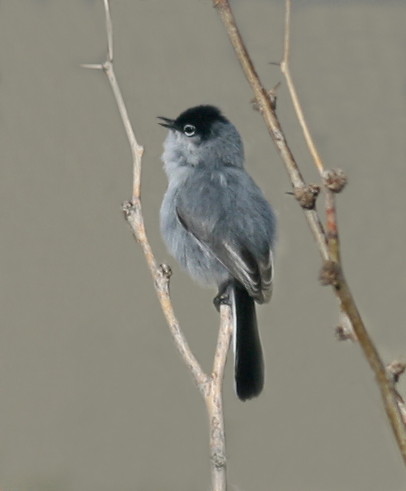
Black-tailed Gnatcatcher,
March 30, 2011, Indian Ranch (Panamint Valley)
Photo
by Tom Heindel
Why do so many reports lack evidence and why do we consider some of them misidentifications? When birders see a species that they assume is expected in an area, they do not study the bird, and quickly change their focus to the next feathered movement. As a good friend says, “They are still good people!” which is a good thing because we all do it! There is a general feeling by many observers that if they are in the desert they will be seeing Black-tailed Gnatcatchers. In Inyo County the Blue-gray Gnatcatcher is a common species in desert habitats. The second problem deals with the similar appearance of the two species. Male Black-tailed Gnatcatchers maintain the distinctive black crown from February to July, which is reduced to a small black streak over the eye the rest of the year. Almost all reports in Inyo County were of female types, which are the most difficult to distinguish. The undertail patterns are distinctive but because of the extremely graduated feathers on a Black-tailed Gnatcatcher, the white tips of the outer tail feathers extend much further up the tail than one might expect. A brief view has fooled more than one observer into thinking he was looking at a Black-tailed, only to watch it morph into a Blue-gray Gnatcatcher. And lastly, the vocalizations of male gnatcatchers in spring are repeated, buzzy notes that have distinctive qualitative differences but just as beauty is in the eye of the beholder, so too are auditory signals. The Black-tailed Gnatcatcher gives a rapid series of buzzy JEE-JEE-JEE-JEE notes in defense of territory or in response to playback. Otherwise both sexes give single buzzy and/or hissy notes. Birders often describe vocalizations of the same bird differently and interpretations of those descriptions also vary, which has led us to not accept heard only reports as records. This is with the caveat that the few observers who reported hearing a Black-tailed Gnatcatcher were likely correct but the evidence provided is not sufficient to rank as an in-lieu-of-specimen, which is necessary to extend the boundaries of what is proven.
Remember, if you are within the known breeding area, the southeastern tip of Inyo County, and you think you are looking at a Black-tailed Gnatcatcher, you probably are and documentation is not necessary. If you are outside the known breeding area and you think you are looking at a Black-tailed Gnatcatcher, prove it! Other researchers are also trying to clarify the range of Black-tailed Gnatcatcher farther south in the Mojave Desert where the overall problems are similar to those in Inyo County. Where are they, and where aren’t they, and exactly what are their habitat needs. We encourage adventurous spirits to take one of the sites outside the known breeding areas and prove, to a scientific certainty, that the range of the breeding population of Black-tailed Gnatcatcher is more extensive in Inyo County than is presently proven! This is an area where birders can make significant contributions to the science of ornithology!
Comments and perspectives, offered by Jon Dunn, Matt Heindel, and Kelli Levinson, were greatly appreciated and added significantly to this article.
Bibliography
-
Fisher, A.K. "Report on the ornithology of the Death Valley expedition of 1891, comprising notes on the birds observed in southern California, southern Nevada, and parts of Arizona and Utah." North American Fauna No. 7:144 (1893).
- Floyd, T, Elphick, C.S., Chisholm, G., Mack, K., Elston, R. G., Ammon, E. M., and Boone, J. D. Atlas of the Breeding Birds of Nevada. University of Nevada Press, 2007.
- Grinnell, J., and Miller, A. H. "The Distribution of the Birds of California." Pacific Coast Avifauna Number 27 (1944).
- Miller, A. H., and Stebbins, R. C. The Lives of Desert Animals in Joshua Tree National Monument [Park]. University of California Press, 1964.
- Patten, Michael A., Guy McCaskie, and Philip Unitt. Birds of the Salton Sea: Status, Biogeography, and Ecology. Berkeley: University of California, 2003.
- Rich, T..D., et al. Partners in Flight: North American Landbird Conservation Plan. Ithaca: Cornell Laboratory of Ornithology, 2004.
- Sauer, J. R., Hines, J. E., and Fallon, J. "The North American Breeding Bird Survey, Results and Analysis 1966 - 2005. Version 6.2.2006." USGS Patuxent Wildlife Research Center, Laurel, MD, 2005.
- Unitt, P. San Diego County Bird Atlas, San Diego Natural History Museum, 2004.
Back to Top
Reports
Wild at Home - a Gardening Workshop
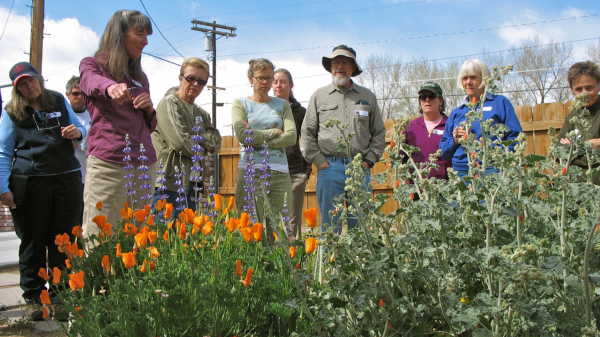
Karen Ferrell-Ingram speaking in the ESLT garden at the Wild at Home workshop
On Saturday, April 23, 2011, almost twenty interested gardeners gathered at the Eastern Sierra Land Trust garden to learn about how to garden for wildlife.Taking inspiration from a garden tour of the Eastern Sierra Land Trust native plant garden, each individual sat and listened to a marathon of information over the course of the morning.
Eastern Sierra Land Trust shared their mission of preserving vital lands in the Eastern Sierra, and how gardening for wildlife in your backyard connects your yard to the broader Eastern Sierra. A garden in your backyard helps to prevent urban areas from becoming a "dead zone" for wildlife.
Chalfant Big Trees Nursery presented a select list of native plants that benefit wildlife - as shelter or for food - that can be purchased from their nursery and grow well in the Eastern Sierra. For example, Mountain Mahogany (Cercocarpus ledifolius) is evergreen, provides good shelter and is also a food source for wildlife.
The Inyo & Mono Master Gardeners touched on a little bit of everything, from design elements to consider when planning your garden to how to keep the plants growing once you have them in the ground. Did you know that you need to think about having a diversity of levels? To have a wildlife friendly garden, you need to have low cover (small shrubs and flowers), medium cover (bushes), and high cover (trees).
Eastern Sierra Audubon spoke about what you will see once you have created a wildlife friendly garden.The key to seeing birds, lizards and butterflies is to slow down and take a moment to enjoy your garden and spy the wildlife.Create a space that is comfortable, easily accessed from the house, and one you would want to sit at for a moment. After all your hard work in the garden, award yourself with a quiet moment and sooner than later you are bound to see a few new visitors in your garden.
Lastly, Eastern Sierra Wildlife Care shared a few dos and don'ts to follow in your garden. Attracting wildlife comes with a responsibility to the animals. For example, don't place a bird feeder too close to a window, as a bird might fly into the window and hurt itself. Be sure to clean out your bird feeders regularly, especially nectar feeders.
We hope that you will begin to be inspired to transform your backyard into a wild home. Whether you add one flowering bush that attracts butterflies or you redesign your entire yard for birds, we imagine you will enjoy the change. Thank you to the following people who made this workshop possible: Pete Pumphrey, Roberta Lagomarsini, Karen Ferrell-Ingram, Hillary Behr, Cindy Kamler, Steve Blair and Carmen Kappos.
For more information on these topics, feel free to contact each organization. You can download Eastern Sierra Audubon's "Ten Common Backyard Birds" poster (shown at right), and a great Bird Feeder handout here: "Meet Your Bird Feeders": http://www.birdfeeding.org/best-backyard-bird-feeding-practices/bird-feeders/meet-your-bird-feeders.html
Serena Dennis
Back to Top
Field Trip Report: Winter Wildlife Field Trip (that wasn't)
Winter wildlife in the Owens Valley…we tried! Originally scheduled for 26 February 2011, this trip was cancelled due to rain, snow, and icy roads on the planned travel route. Logistically it could not be re-scheduled until 19 March.
Late in the afternoon of 18 March, a major fire advanced towards Big Pine and reached some of the area to be explored. Mandatory evacuation was ordered, again cancelling the trip planned for the following morning.
When thoughts of re-scheduling surfaced, a delightful low-budget movie entitled The Gods Must Be Crazy came to mind. It was about an African aboriginal belief that if things were not going right it was because the gods were angry. Points we considered before re-scheduling again were 1) winter is now past, 2) Crater Mountain, a few miles south of Big Pine has been blissfully quiet for a long time, 3) The last huge earthquake was in 1872 in Lone Pine, and 4) If California splits off into the Pacific Ocean, our beach front property could host a tsunami! Then we remembered a bumper sticker… "Mother Nature Bats Last!" … and decided that we better wait until next year and hope she has been given reason to regain her composure and sense of humor. Hope to see you all in February 2012!
Tom & Jo Heindel, Trip Leaders
Field Trip Report, Spring Migration Birding Near Bishop, April 22
In delightful weather, nine participants peered through greening vegetation off Dixon and Brockman Lanes near Bishop. We welcomed neotropical migrants such as a Western Kingbird, Wilson's Warbler and Empidonax flycatchers. An Osprey soared; a Great-horned Owl perched. Western Bluebirds, not at all unusual here this past winter, showed their colors, as did a Red-breasted Nuthatch. The onslaught of Yellow-rumped Warblers couldn't be missed. How quickly do these hours fly!
Larry Nahm, leader
Back to Top
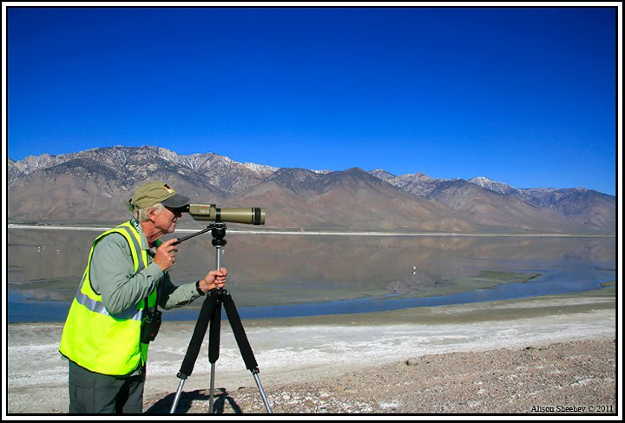
Tony McHugh, at Owens Lake Big Day, 19 April 2011
Photo by Ali Sheehey
2011 Owens Lake Spring Big Day Census: 58,589 total birds
The fourth annual Owens Lake Spring Big Day was held on April 19, 2011, under perfect spring-like weather conditions. This year’s event was organized by Mike Prather, Eastern Sierra Audubon Society, and Debbie House, Los Angeles Department of Water and Power (LADWP), Watershed Resources Specialist. The twenty seven participants included birders from San Diego to Berkeley, as well as locals from Lone Pine to Mammoth Lakes, and five LADWP staff biologists.
The entire 40 square miles of the Owens Lake Dust Control Project and several shoreline spring sites were surveyed. A total of 58,589 birds and 73 species were recorded. Highlights of the count include 18,978 Calidris sandpipers including Least Sandpiper, Western Sandpiper and Dunlin, 8,200 American Avocet, 153 Greater Yellowlegs, 95 Black bellied Plover, and 58 Willet. Of the over 4,900 waterfowl recorded, Gadwall and Ruddy Duck predominated, while three Blue-winged Teal and one Red breasted Merganser were among the “less frequently encountered” waterfowl species recorded for the day. It was a five gull day at Owens Lake, with California Gulls virtually everywhere (23,248 of them tallied), and five Franklin’s Gulls, a dozen Bonaparte’s Gulls, a few-dozen Ring-billed and a couple Herring Gulls thrown into the mix.
LADWP and the Eastern Sierra Audubon Society would like to thank all who participated. The information from lake-wide Big Day counts is being incorporated into LADWP’s growing database of wildlife use of the Owens Lake Dust Control Project, and will be used to help guide management decisions regarding maintaining or improving wildlife habitat, while implementing water conservation efforts and continuing to meet dust control requirements.
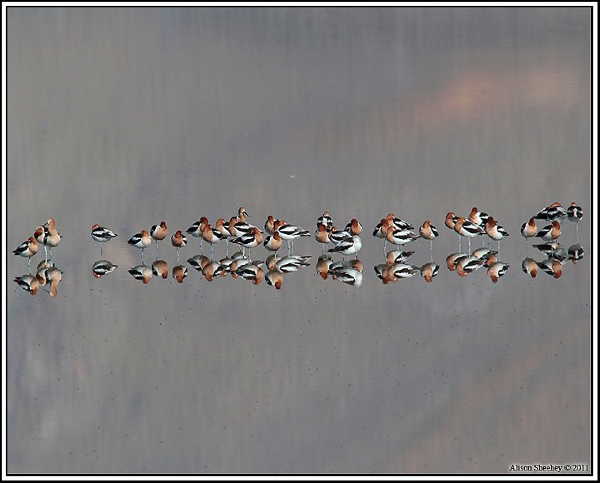
American Avocets, Owens Lake Big Day, 19 April 2011
Photo by Ali Sheehey
Back to Top
Conservation News
Conservation Alert: Bodie Hills Pinyon Pines
Janet Carle originally wrote this letter to the editor to SierraWave.net
BODIE HILLS PINYON CREEP: Is it worth spending big bucks?
A few weeks ago, my Letter to the Editor about BLM's plans to manipulate 16,000 acres in the Bodie Hills was focused on letting people know about the project and how to send in comments. Since then, I have read the study results from the experimental plots done in 2007, visited the "treatment" sites, and given it all more thought. Here are the concerns I will mention in my comments to BLM.
This Project Needs an Environmental Impact Statement
The scope is huge. Wilderness Study Areas are of special concern and perhaps should not be massively manipulated. The research is not conclusive on benefits gained. More study time is needed in the experimental plots. Three years is not enough data.
Cost
According to the reports provided by BLM , the cost of "mastication" (chewing up existing vegetation with a huge machine) is $738 per acre. Cut, pile and burn (crew with chainsaws cuts down trees, piles them up and later burns the piles) is $439 per acre. Using a conservative average of $500 per acre, this project of 16,000 acres over 10 years will burn through 8 MILLION DOLLARS. Is cutting down healthy trees because they are increasing their range due to fire suppression and warming temperatures, among other things, really the best use of this public money?
Benefit
BLM has 2 reports available on the experimental plots. One, conducted by Point Reyes Conservation Science, looks at birds in the plots. After a 3 year study (2 dry years and one wet) the results are inconclusive. There were more nesting birds and better nesting success in the untouched control plots than in the treated areas, according to BLM's own report.
The other report is about vegetative response to the treatments. Again, things are inconclusive. The best results overall are in the areas where the pinyon forest was not dense to begin with. Here is the link to the report: Evaluating the Effects of Pinyon Juniper Thinning Treatments at a Wildland/Urban Interface
Fire Safety
BLM has told us that local communities will be safer from fire by "treating" thousands of acres. The fact remains, however, that most of the area proposed to be manipulated is far from communities. I asked a BLM official in 2007, "Why don't you spend this money to reduce fuel load near communities where it is really needed, not in a place 5 miles from the nearest houses?" His answer (paraphrased) If we start thinning near towns, everyone wants us to do their place, and if we don't, they might sue us if a fire comes. It's easier to do this stuff where there aren't a lot of people.
How about putting some of those millions into a firebreak around the town of Bodie, or buying a new fire truck for Bodie, or upgrading the fire hydrant system at Bodie?
A More Reasonable Approach?
After visiting the test plots today, it seems that a more reasonable approach would be to focus on areas at the edge of the pinyon forest, where the trees are scattered . It would be possible to cut down the small pioneering trees on the edge of the sagebrush scrub, much like trees are thinned in Yosemite to maintain desired meadows. To cut down healthy trees on thousands of acres to return them to sagebrush, when oceans of sagebrush surround Mono Lake, seems to be a hopeless task and a waste of money. Obviously, the natural prevailing conditions are favoring the pinyon trees. As I said before, the trees are a carbon sink and we are lucky our pinyons aren't dying en masse like those in Arizona.
Sage grouse habitat can be targeted and perhaps some pinyon removal and prescribed burns done in the most important areas.
Please send in your comments to BLM as soon as possible. They need to hear from us, the citizens of the Eastern Sierra. Send comments to cabipubcom@ca.blm.gov. For a "Notice of Proposed Action" document with all the details, email Heather at heswartz@fs.fed.us.
Janet Carle
Mono City
Back to Top
Mono Lake Tufa State Natural Reserve Needs Your Support
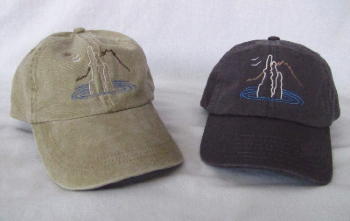
Buy a hat and help support the Mono Lake Tufa Reserve
And you need a hat (don't you?)
Help support the Mono Lake Tufa State Natural Reserve by buying a baseball cap! Yes, that’s what we have to do to help keep the Reserve staffed. As budgets continue to be reduced, we’re turning to merchandise sales to help support the interpretive position at the Reserve. Funds from donations and merchandise sales go directly to the Friends of Mono Lake Reserve, a new non-profit that has been created to generate revenue to help staff the Reserve. Profits from hat sales go directly into funding the following:
- Public interpretive/nature walks including bird walks
- Protection and monitoring of State Park lands
- Maintenance of interpretive trails at the lake shore
- Roving and patrol of visitor use areas by interpretive staff
- Coordination of school field trips at the lake
- Birding by Ear workshops
- Planning the Mono Basin Bird Chautauqua
- Volunteer training and coordination
Hats cost $20.00, including postage and handling. Sorry, we are not set up to take credit cards, but you can mail your hat order and check to:
Mono Lake Tufa State Reserve
P.O, Box 99
Lee Vining, CA 93541
Checks should be made payable to FOMLR (Friends of Mono Lake Reserve). For more information email us at: monolake@schat.net Thanks for your support!
Back to Top
Mono Lake Needs You!
Volunteer Program at Mono Lake this Summer
The Mono Lake Committee, US Forest Service, Eastern Sierra Interpretive Association and California State Parks are teaming up to sponsor a volunteer program at Mono Lake this summer. Volunteers will have the opportunity to meet people from all over the world and share their knowledge of the Eastern Sierra.
Volunteers may staff information desks, rove and answer questions at the lakeshore, or guide formal tours for groups.
Free training will be held in the Mono Basin on May 25 and 26, June 1, 2, 8 and 9 (Wednesday and Thursday afternoons 1-4 pm).
Please contact Janet at 760-647-6431 or Erika at erika@monolake.org for more information or to sign up. You will be sent details and a training schedule.
Back to Top
Devil's Postpile Bird Data Project in Need of Volunteers
For the past several years the folks at Devil's Postpile have been working with PRBO to collect bird data. Times being what they are, the funds for that effort have run out. The National Park Service would like to continue to move some of the data compilation forward using volunteers to work on breeding surveys and bird counts. They have asked for support in this effort from members of Eastern Sierra Audubon. Schedules have not yet been set. Volunteers would receive a pass so they would not have to pay the vehicle fee to get to the park. If you would like to get more information about how you can volunteer and be connected with the park service for that purpose, contact Pete Pumphrey at pcpumphrey@schat.net.
UPDATE - May 13, 2011 - more detailed description:
Devils Postpile is looking for volunteers with good eyes and ears for bird
identification to assist with bird counts within the monument this summer.
Volunteers should be proficient in identifying Sierra birds by sight, song,
or call. This is a great opportunity to sections of the monument less
traveled! Some moderate off-trail hiking will be required to complete the
bird counts. Map reading and basic GPS skills are helpful. Dates and times
are flexible and will be announced soon. Entry into the monument will be
free for registered volunteers. For more information, contact Maureen
Finnerty, Devils Postpile Volunteer Coordinator at 760-924-5505.
Thanks so much for helping us get birders into the monument!
Maureen Finnerty
Park Ranger,
Devils Postpile National Monument
760-924-5505
760-934-2289 (June-October only)
Back to Top
Windows and Birds
We get questions about what works on windows that keep birds from slamming into them and can't provide any solid information. Here is a website with a bunch of information. Scroll down for a number of URLs that offer different options. The rest of Sibley's website is a treasure trove of top-of-the-line bird information as well... and besides he is one of the really, really nice guys!
http://www.sibleyguides.com/2010/08/new-york-times-on-windows-and-birds/
Tom & Jo Heindel
Back to Top
Taking Care of Business
Welcome New and Renewing Members!
Eastern Sierra Audubon would like to thank the following new members for their support:
January 2011
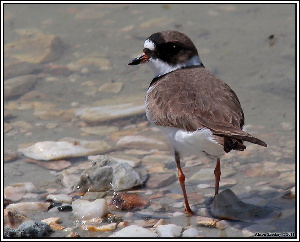
Semi-palmated Plover
photographed at the 2011 Owens Lake Big Day
by Ali Sheehey
- Maggie Wolfe Riley
- V. Older
- Leland Brown
- G. Doug Thornburg
February 2011
March 2011
New (and/or renewing) Chapter-only Members:
- Yvonne A. Wood
- Tom and Julie Anne Hopkins
We would also like to especially thank all the renewing members whose donations help keep this chapter alive! We get 8-10 renewing members a month, and from 3-5 new members. Your membership dues make it possible for us to offer and support great educational and recreational events throughout the eastern Sierra.
If you would like to join and help support Eastern Sierra Audubon, there are two ways you can do it:
- Join as a National Audubon Society Member, designating ESAS as your chapter affiliation. Includes Audubon Magazine subscription. This is $20 for the first year, and goes up to $35 annually thereafter.
- Join as an ESAS Chapter-only member for $20 per year. Now that we do the newsletter online, you no longer need to join to receive it, but your chapter membership is a way to give back, and show your appreciation for all that ESAS does, and to help support our many programs.
Click Here for a membership form to join or renew!
Join National Audubon - your zip code will associate you with the chapter nearest you.
Back to Top
How You Can Help ESAS: Four R’s and a V!
Renew your membership (or join)! The money from your membership dues is what helps us bring great evening programs, special events, educational programs, trips, this website, and more to the community - we need your support!
Recycle at Manor Market and tell them to donate the money to Eastern Sierra Audubon.
Respect property and get permission to bird on private or restricted access property.
Repeat! Spread the word about programs and events, encourage others to join and participate.
Volunteer! Come to a board meeting and consider volunteering for an open board position! We need a program coordinator, and we always need volunteers for Birds in the Classroom, participants in bird counts, Bird-A-Thons, etc.
Message from the Editor
Summer is coming!
Hello Newsletter Readers! This is our last issue for the 2010-2011 year - we will take a break over summer and be back in the fall with our September-October issue. The Bird ID Challenge will be back then, too. You are welcome to send submissions for future newsletters and also the monthly email at any time, though. We may still send out no more than one email each month to remind you of upcoming events - if you are not on our email list, please add yourself so you don't miss anything! If you send items to the newsletter editor by the last week of any month, we'll make sure they get included in the next issue.
Please Contribute!
Speaking of sending in items for the newsletter...
All of our content is supplied by our awesome members... if you have any ideas about articles you’d like to see, or better yet, if you have anything to share for newsletter publication, whether an article, a news item, update, correction, poem, essay, artwork, photo, field trip report, neat birding experience, letter, etc, please send it, along with any comments or suggestions, to maggiewolfe@gmail.com. We’d love to hear from you!
You may send items for inclusion in the newsletter at any time, but please send any timely items to arrive before the first of the month, so they can be included in the monthly email update. The next official newsletter will be September/October 2011, so send submissions to arrive by the last week in August at the latest. We will try to send out email updates on the first of every month to include any reminders or timely articles for that month.
Thanks for reading, and happy birding!
Maggie Wolfe Riley, Newsletter Editor
Back to Top
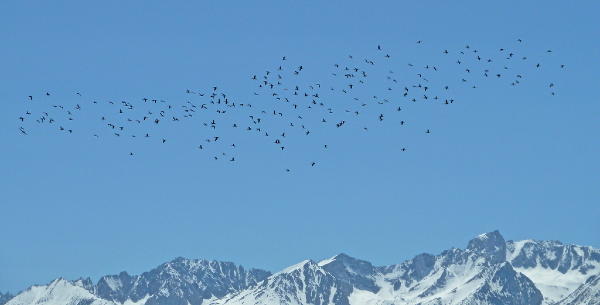
White-faced Ibis flock over Bishop - Photo by Chris Howard
Bird Quiz Answer:
The mystery bird is a Long-eared Owl. The important field marks in the photo are the tall, closely spaced ear tufts, the bird's very erect posture, and the vertical markings through the yellow eyes.












